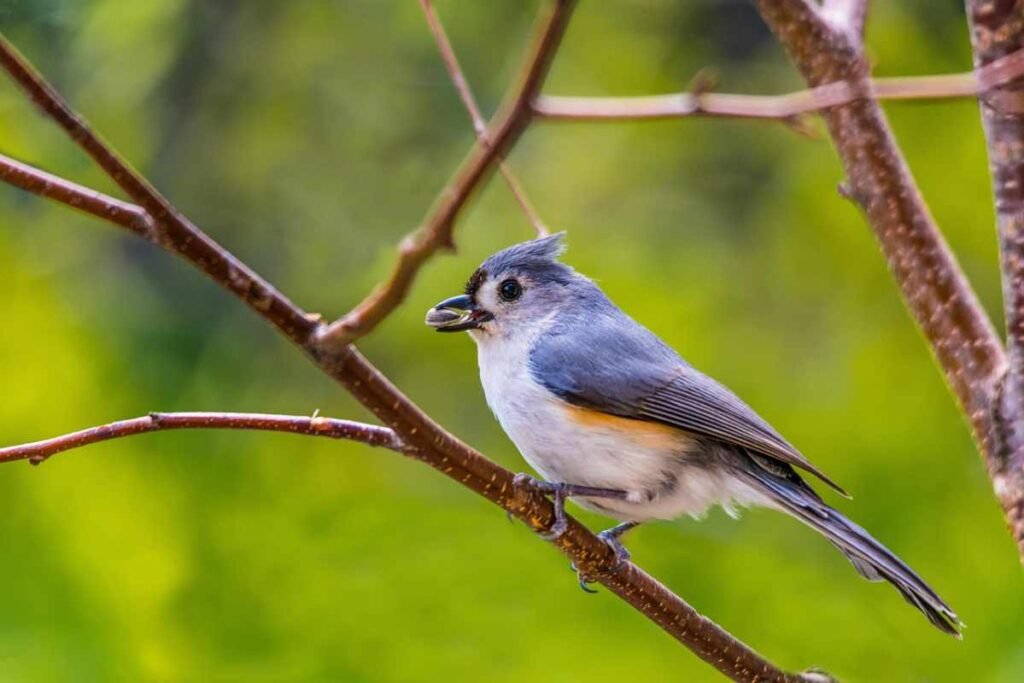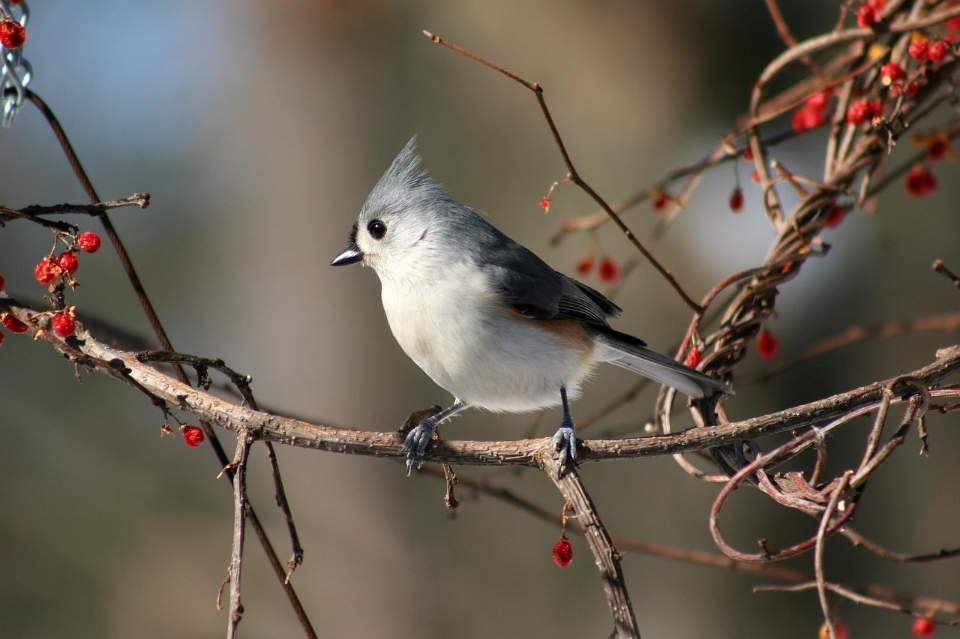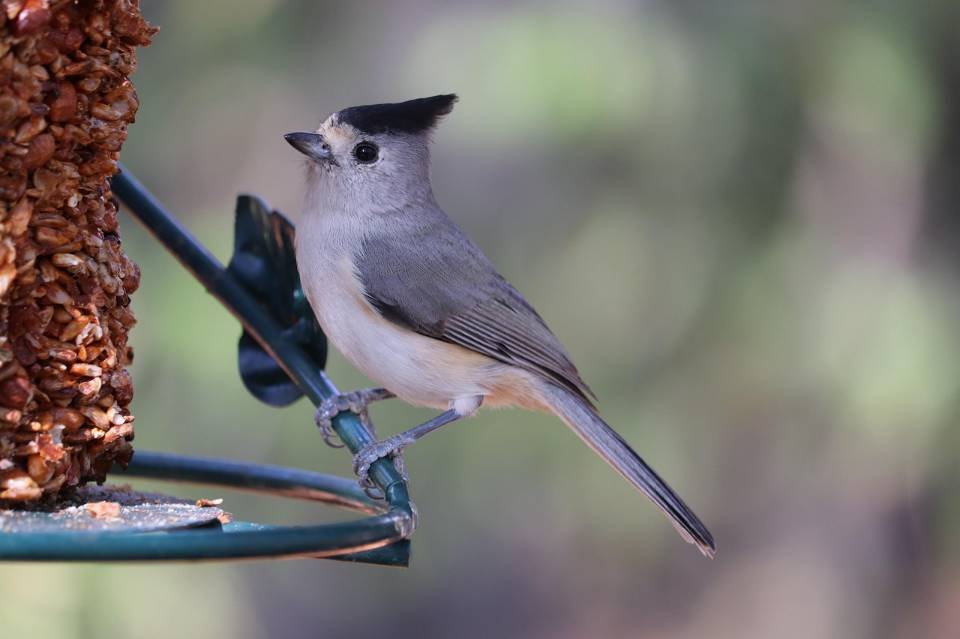You’re scrolling through bird identification apps at 6 AM (don’t judge, we’ve all been there 😳), trying to figure out what that adorable little gray bird with the punk rock hairdo was doing at your feeder yesterday. Sound familiar? The Tufted Titmouse has this magical ability to show up in your backyard one day and completely steal your heart with their curious antics and that unmistakable crest that looks like they stuck their wing in an electrical socket.
I remember the first time I spotted one of these little characters hanging upside down on my suet feeder, completely unbothered by gravity while giving me the stink eye. That moment sparked a deep curiosity about where exactly these birds call home, and trust me, their habitat preferences will surprise you in the best possible way.
📌 Quick Answer: Where Does the Tufted Titmouse Live?
- Range: Eastern United States, from southern Maine to Florida, and west to parts of Nebraska, Kansas, and Texas.
- Habitats: Mature deciduous and mixed forests, suburban neighborhoods with big trees, parks, and even golf courses with wooded edges.
- Nesting: Natural tree cavities, old woodpecker holes, or nest boxes about 3–20 feet high.
- Year-Round Resident: They don’t migrate. You’ll see them at feeders and in yards throughout the year.
- Diet Connection: Closely tied to oak trees for acorns and insects.
The Tufted Titmouse’s Geographic Range: It’s Bigger Than You Think
Tufted Titmouse live across a surprisingly vast area of North America (According to American Bird Conservancy), and their range has actually been expanding northward over the past few decades. We’re talking about a distribution that stretches from southern Maine all the way down to the Gulf Coast, and from the Atlantic seaboard west to the Great Plains.
The core of their range covers the entire eastern United States, with the highest populations concentrated in the southeastern states. These birds absolutely thrive in places like Georgia, the Carolinas, Virginia, and Tennessee. But here’s where it gets interesting: they’ve been steadily pushing their boundaries northward and westward.
The Northern Expansion Story
Climate change and human habitat modifications have opened up new territories for Tufted Titmouse populations. They’ve colonized areas of southern New England, southern Michigan, and parts of Wisconsin where they were virtually unknown just 50 years ago. I’ve talked to birders in Vermont who now regularly spot them at feeders, something that would have been unthinkable in the 1970s.
The western edge of their range extends into eastern Nebraska, Kansas, and Oklahoma, though populations get pretty sparse once you hit the Great Plains. These birds seem to have a love-hate relationship with wide open spaces, preferring areas with at least some tree cover.
Preferred Habitats: Where Tufted Titmouse Actually Want to Live
Ever wondered why some yards attract Tufted Titmouse while others never see them? These birds are incredibly picky about their habitat requirements, and understanding their preferences is key to spotting them in the wild or attracting them to your property.
Mature deciduous and mixed forests represent their absolute favorite habitat (according to National Audubon Society). We’re talking about well-established woodlands with a mix of oak, maple, hickory, and other hardwood trees. These forests provide the perfect combination of nesting sites, food sources, and protective cover that titmice crave.
The Suburban Sweet Spot
Here’s something most people don’t realize: Tufted Titmouse have become remarkably successful suburban birds (According to Birdfy). They’ve figured out that residential neighborhoods with mature trees offer many of the same benefits as natural forests, plus the added bonus of bird feeders and consistent water sources.
Parks, cemeteries, and tree-lined neighborhoods often support thriving titmouse populations. I’ve found some of my most reliable titmouse watching spots in older suburban developments where the trees have had 30-40 years to mature and create that woodland-like canopy these birds prefer.
Golf courses with wooded areas also attract titmice, especially those courses that maintain naturalized rough areas and preserve existing tree cover. The combination of open foraging areas and nearby trees creates an ideal habitat mosaic.
Elevation and Climate Preferences: The Goldilocks Zone
Tufted Titmouse generally prefer elevations below 2,000 feet (According to All About Birds), though you can occasionally find them at higher altitudes in the Appalachian Mountains. They’re not exactly mountain climbers, preferring the gentler terrain of foothills and river valleys.
Climate-wise, these birds favor areas with moderate temperatures and adequate rainfall. They struggle in extremely cold regions (hence their historical absence from northern New England) and in arid western areas where tree cover becomes sparse.
Seasonal Habitat Shifts
Unlike many bird species that migrate long distances, Tufted Titmouse are year-round residents throughout most of their range (According to Long Point Basin Land Trust). However, they do make subtle seasonal habitat adjustments that can affect where you’ll spot them.
During breeding season (March through July), they become more secretive and stick closer to dense forest areas where they can find suitable nesting sites. Winter months bring them closer to human habitation as they search for reliable food sources, which is when you’re most likely to see them at backyard feeders.
Fall and early winter represent prime titmouse watching seasons because these birds become much more active and visible as they cache food for winter storage. FYI, watching a titmouse frantically stuffing sunflower seeds into tree bark crevices is pure entertainment.
Nesting Site Requirements: They’re Surprisingly Specific
Tufted Titmouse nest in natural tree cavities (As reported by Perky Pet), and they’re remarkably picky about their real estate choices. They prefer cavities in dead or dying trees (called snags) that are typically 10-30 feet off the ground, though I’ve found nests as low as 4 feet and as high as 50 feet.
Oak trees seem to be their absolute favorites for nesting sites, followed by maple, hickory, and other hardwoods. The decay patterns in these tree species create cavities with the right dimensions and structural integrity that titmice prefer.
The Cavity Competition Game
Here’s where things get competitive: Tufted Titmouse face serious competition for nest sites from other cavity-nesting species. House Wrens, chickadees, nuthatches, and even flying squirrels all compete for the same prime real estate.
This competition has driven titmice to become remarkably adaptable about their nesting choices. They’ll use artificial nest boxes (though they prefer natural cavities), old woodpecker holes, and even unusual locations like mailboxes or decorative birdhouses if the dimensions are right.
I once found a Tufted Titmouse nest in an old wooden fence post that had developed the perfect cavity after years of weathering. These birds definitely think outside the box when necessary.
Food Source Distribution: Following the Oak Trees
Tufted Titmouse distribution closely follows oak tree distribution across eastern North America, and this isn’t a coincidence. Oak trees provide crucial food sources throughout the year, from acorns in fall to insect populations during breeding season (According to National Audubon Society) .
Acorns represent a critical winter food source for titmice, and areas with diverse oak species can support much higher titmouse populations. Red oaks, white oaks, and chestnut oaks all produce acorns at different times, creating an extended harvest season.
The Insect Connection
During breeding season, insects become the primary food source for adult titmice and essential nutrition for growing nestlings. Caterpillars, beetles, aphids, and other small insects found on oak leaves provide the high-protein diet necessary for successful reproduction.
Areas with diverse tree species support more diverse insect communities, which in turn support larger titmouse populations. This explains why mature, mixed forests consistently host the highest densities of these birds.
Suburban areas with native plantings can also support good insect populations, especially when homeowners avoid pesticide use and maintain naturalized landscaping approaches.
Urban Adaptation: City Birds with Country Tastes
Tufted Titmouse have shown remarkable adaptability to urban environments, though they’re much more selective than some other bird species. They need urban areas that maintain significant tree cover and offer suitable nesting opportunities.
Central Park in New York City supports a thriving titmouse population, as do similar large urban parks across their range. The key seems to be having sufficiently large patches of mature trees that can provide both food and nesting resources.
What Makes Urban Habitat Work
Successful urban titmouse habitat requires several key elements:
• Mature tree canopy covering at least 40% of the area • Mix of native and non-native tree species providing year-round resources
• Adequate nest site availability through preserved snags or nest boxes • Minimal pesticide use maintaining healthy insect populations • Reliable water sources from fountains, streams, or bird baths
Cities that maintain these habitat elements can support surprisingly robust titmouse populations. I’ve documented healthy populations in places like Washington D.C., Atlanta, and even parts of downtown Richmond where urban forestry programs have preserved significant tree cover.
Range Expansion and Climate Change: The Moving Target
Tufted Titmouse range has expanded significantly over the past 50 years, with populations establishing themselves in areas where they were previously unknown. This expansion appears to be driven by a combination of climate warming and habitat modifications.
Warmer winters have allowed titmice to survive in more northern latitudes where cold temperatures previously limited their range. The widespread use of bird feeders has also provided reliable winter food sources that help support populations at the edge of their range.
Future Distribution Predictions
Climate models suggest continued northward expansion of Tufted Titmouse range over the coming decades. Areas of southern Canada, northern New England, and the upper Midwest may see establishing populations if warming trends continue (According to American Bird Conservancy).
However, southern populations may face challenges as temperatures increase beyond their comfort zone and drought conditions affect food availability. The species’ range may essentially shift northward rather than simply expand.
Urban heat island effects could actually benefit titmice in northern cities while creating challenges in southern urban areas. IMO, these birds are likely to become even more common suburban residents as they adapt to human-modified landscapes.
Water Requirements: The Often Overlooked Factor
Access to reliable water sources plays a crucial role in Tufted Titmouse habitat selection, though this requirement often gets overlooked in habitat discussions. These birds need water for drinking, bathing, and maintaining their feathers in good condition.
Natural water sources like streams, ponds, and seasonal pools within forested areas provide ideal habitat components. Areas lacking natural water sources can still support titmice if artificial sources like bird baths or dripping faucets are available.
I’ve noticed that titmouse activity increases dramatically around my yard during dry spells when I maintain fresh water in multiple locations. They seem to prefer shallow water sources where they can bathe safely while maintaining visual contact with potential threats.
Regional Habitat Variations: Not All Titmice Are Equal
Tufted Titmouse habitat preferences vary subtly across their range, with populations adapting to local conditions and available resources. Understanding these regional differences can improve your chances of finding them in specific areas.
Southeastern populations tend to prefer more diverse forest types and can thrive in pine-hardwood mixtures that northern populations avoid. Northern edge populations stick more closely to mature hardwood forests and are less tolerant of habitat fragmentation.
Western populations show increased tolerance for drier conditions and more open habitats, likely reflecting adaptation to the transition zone where eastern forests give way to Great Plains grasslands.
Local Habitat Hotspots
Every region within the titmouse range has specific habitat types that consistently produce the best birding opportunities. River bottomlands, state parks with mature forests, and well-established residential areas typically offer your best chances of titmouse encounters.
Nature preserves and wildlife refuges often provide perfect habitat combinations, especially those that manage for diverse forest structure and maintain snag availability for cavity-nesting species.
The next time you’re wondering where to look for Tufted Titmouse, remember that these adaptable little birds have figured out how to thrive in a remarkable variety of habitats across eastern North America. Whether you find them in a pristine old-growth forest or hanging upside down at your suburban bird feeder, you’re witnessing the success story of a species that’s learned to make the most of both wild and human-modified landscapes 🙂




